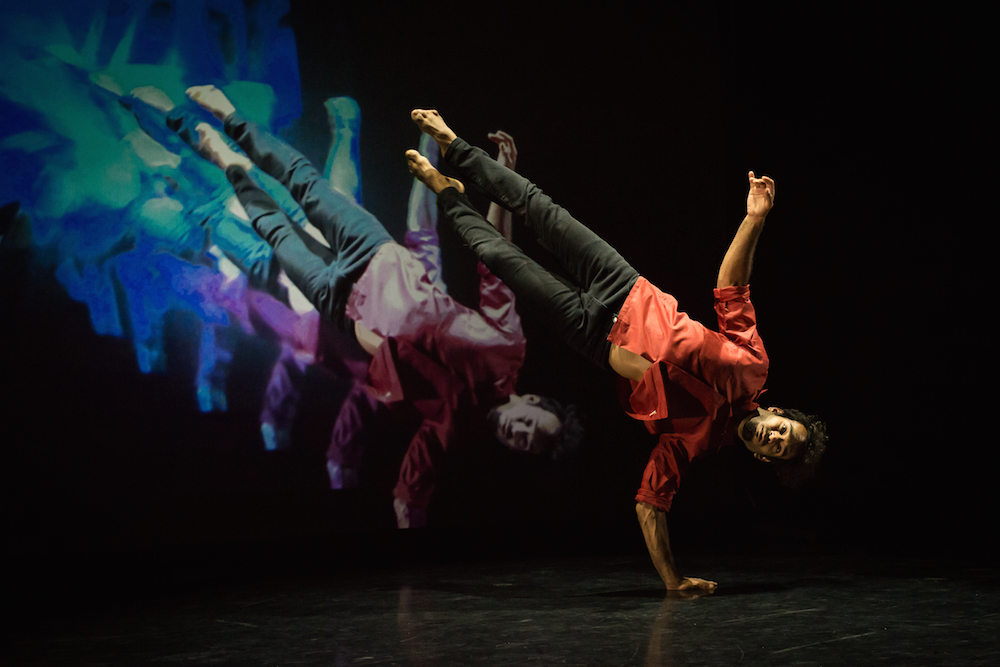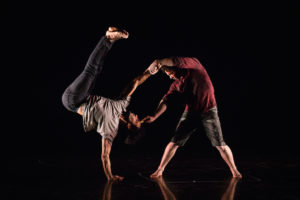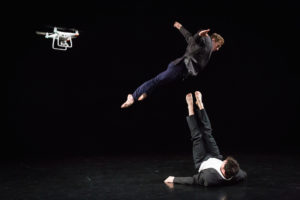Seeing the Vortex: NobleMotion Celebrates Ten Years

All photos by Lynn Lane
How is art relevant? This question is ever-present within the arts landscape. People continue to ask how and why the arts are and should remain relevant, especially in an age when competition is fierce and time is limited. However, when a dance company’s mission is to create art that thoughtfully integrates technology, the question is no longer “how is it relevant?” but “how is it not?”
Andy and Dionne Noble founded NobleMotion Dance ten years ago, and their latest program, Vortex, is a celebration of that milestone. The program consists of nine works, eight by the professional company and one by their youth company (NMD2), and includes rocking set pieces, flying drones, and live video feed. In anticipation of their upcoming show, I spoke with Andy and Dionne about their artistic practice, their use of technology, and what celebrating ten years means to them.
This interview has been edited and condensed for length and clarity.
 What about technology fascinates you?
What about technology fascinates you?
Andy: Well, I believe that any art form reflects on its time, whenever that is. Our time right now is inundated with technology. Man versus machine is one of the most relevant themes in our society right now. As such, using the medium of technology allows for the reflection of that theme within our work. Additionally, our work is often very cinematic, so technology helps us achieve that. Technology allows us to alter and twist the space which allows audience members to view dance in a different way.
Dionne: Technology gives us the opportunity to layer onto our work and create deeper meaning at times. I think dance is enough most of the time, but it’s nice to add another layer. I tend to use technology for its ability to generate imagery through graphic design, and I use that imagery to inform my work.
I noticed you both studied dance and technology in grad school. What did ‘dance and technology’ mean when you were in grad school, and what does it mean now?
D: I finished grad school in 2002. In terms of comparing the theories surrounding dance and technology, a lot of the concepts remain the same: not allowing technology to overwhelm the dancer, asking how does it enhance the art form, etc. In terms of the software and machinery, there has been rapid growth and development. However, sometimes the newest gadget won’t help or add to the question we are seeking to address in our work.
A: I completed grad school in 2008. I believe that movement and technology have always gone hand in hand. Take Loie Fuller and Busby Berkeley, for example. What has really changed is that every student has access to technology. It’s everywhere. The way we have to market our shows speaks to that. We have to create the show before the show even exists. We use social media, short films, and dynamic photographs to create the drama of the evening before it even begins.
 How do you choose which forms of technology to use in a piece?
How do you choose which forms of technology to use in a piece?
A: Sometimes the technology informs the dance. Other times, the technology serves the concept, like Drone. Drone was born out of dancers contact improving with their eyes closed. Beautiful things were happening, a kind of listening. I wanted to see if I could capture that in a work. Afterwards, I realized that the work was not going to read well in The Hobby Center. It was too intimate of a piece. One of the dancers suggested a drone, and I think the drone serves the work well. It poses the question: What does it say when performers are on stage with their eyes closed, performing an intimate dance, all while being watched?
What are some key learning points you have learned over the past ten years as individual choreographers and as partnered choreographers?
A: As artists, we aren’t taught to be business people. We had to learn how to run a nonprofit. We self taught ourselves a lot of the way, and it was definitely the biggest learning curve. In regards to our choreography, Unsinkable really captures what we’ve learned over the past ten years. It uses fourteen dancers who are executing epic movement on rocking set pieces. It’s one of the more complicated pieces we’ve made because we’re moving a lot of bodies in the space and on set pieces that move while also managing music and telling a meaningful story. Ten years ago, we wouldn’t have been able to handle all of these challenges at the same time.
D: Mine might be a bit more personal. I’ve learned to trust myself. I now trust that when I’m working with Andy and the other collaborators, my voice is important. I also learned to trust myself when I’m working alone and to know that I am capable and don’t necessarily need the help from the others. The more you do it, the more experience you get, the more confident you get. It’s empowering. Then you become an example, and you want to set an example. I think that is important, especially as a woman.
When viewing Vortex, is the audience meant to view each piece independently, or should we expect to identify a through-line?
D: They are individual pieces. But I would say that if there is a through-line for this particular evening, it is asking the questions: What do we see? Who’s watching us? Where are we looking? Axiom has mirrors. Drone has a drone. Couplet has an ending look that is very meaningful. There is something about seeing, using your eyes, and being aware of what’s around you, in all very different ways.
NobleMotion Dance is presenting Vortex on August 24th and 25th at 7:30 PM in The Hobby Center’s Zilkha Hall. Purchase tickets here.



Recent Comments